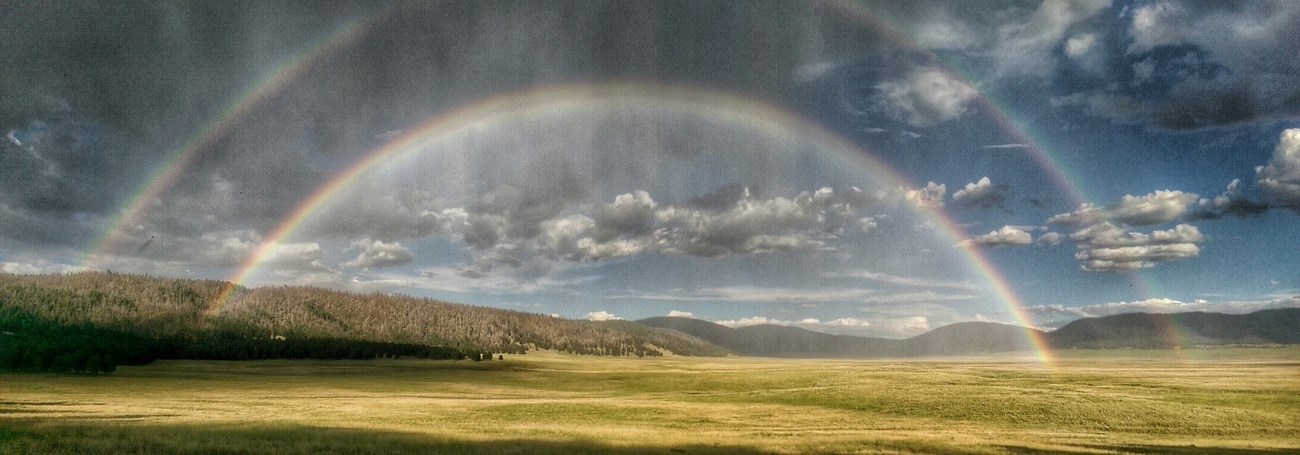Part of a series of articles titled NRCA 2022: Condition of Valles Caldera’s Natural Resources and Scenic Views.
Article
How’s the View? We’ve Been Looking at that at Valles Caldera

© Eric Draper
At Valles Caldera National Preserve, beautiful views abound thanks to the preserve’s “distinct topographic mosaic of expansive valley meadows, lush forested volcanic domes, meandering valley streams, and old growth ponderosa pine (Pinus ponderosa)…,” which are “in striking contrast to the arid New Mexico landscapes at lower elevations” (Valles Caldera National Preserve Foundation Document, 2018, NPS).
But how good are views in the park when you consider both natural and human-related features? And what can negatively impact a scenic view?
A scenic view can be negatively impacted by…
Human development like roads and highways, fences, powerlines, buildings, and oil and gas developments, and associated effects like air pollution, can detract from scenic views. Natural features that are in poor condition can also detract from a view, such as streams or lakes with litter or fouled water, or large amounts of nonnative invasive plants. Activities outside of a park, such as energy development and production, and nighttime light pollution from nearby and distant communities, can affect views within the park as well.
Assessing conditions of visual resources at Valles Caldera
A recent Natural Resource Condition Assessment (NRCA) through the NPS NRCA Program focused on seven resources in Valles Caldera, including visual resources. NRCAs evaluate natural resource conditions so that parks can use the best available science to manage their resources.To assess visual resources at the preserve, ecologists at Utah State University used methods from the NPS Air Resources Division to determine the daytime condition of scenic views at seven locations in the preserve. All locations were chosen by park staff and were in the south-central area of the park. The assessment method relies on the professional judgement of those evaluating the views and uses two measures:
- Scenic quality. With a high condition rating, most views include landscapes in good condition with very few, or minor, features that detract from desirable visual characteristics. The majority of views are also aesthetically pleasing and memorable because of bold forms and colors.
- View importance. With a high condition rating, views are key to the purpose of the park and a primary reason that visitors come to the park. Views are highly publicized and extensive effort goes into facilitating the visitor experience for scenery.

What did we learn?
- Scenic quality (the first measure) was rated as high, moderate, or moderate-high, depending on location, at the seven locations where it was assessed.
- View importance (the second measure) was rated as high at all seven locations.
- Combining the two measures, the overall condition of visual resources is good. Views include landscapes with very few or minor impairments; they are key to the preserve’s purpose; and they serve as a primary reason for park visits.
- The main features inconsistent with natural scenery at the seven locations were preserve roads, fencing, downed trees, unhealthy trees, powerlines, and sheep and cattle grazing infrastructure (such as corrals, fences, stock tanks, and earthen dams). Additional detractions exist in other parts of the preserve and include logging roads on the volcanic domes, burned forests, invasive grasses, and military overflights.
- Because the assessment focused on locations in only one area of the preserve, the ecologists could not determine which preserve areas have the most pristine views. However, data from the NPS Natural Sounds and Night Skies program indicate the western portion of the preserve is the most pristine in terms of light and sound pollution.
- Additional sampling is needed throughout the park to inform zoning and wilderness planning, to serve as a guide for the preserve’s research permitting process, and for obtaining a baseline condition of visual resources on a park-wide scale.

What can park managers do with this information?
- The results of this study provide a baseline for future zoning or wilderness planning for the seven locations where visual resources were evaluated.
- Park managers identified some possible “next steps,” such as using repeat photography to document landscape change over time.
- Another idea is to prioritize key vistas and monitor and/or manage the visual resources, potentially partnering with adjacent land agencies/owners.
Also note that while this assessment was on daytime visual resources, a dark night sky is an important aspect of maintaining high-quality views. Valles Caldera National Preserve was designated an International Dark Sky Park in February 2021 by the International Dark-Sky Association! You can read more about it here.
Information in this article was summarized from: Struthers K, Baril L, Brunson M. 2022. Natural resource conditions at Capitol Reef National Park: Findings & management considerations for selected resources. Natural Resource Report. NPS/NCPN/NRR—2022/2406. National Park Service. Fort Collins, Colorado. https://doi.org/10.36967/nrr-2293700
Read More about the 2022 Valles Caldera NRCA Project >
Visit the NRCA Program Home>
Last updated: January 12, 2023
